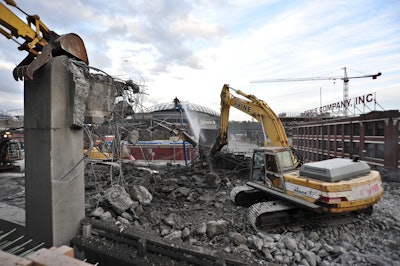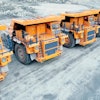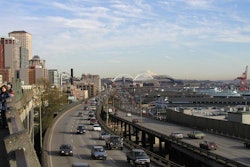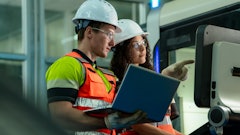
Information from this article was first published in Demolition Magazine and is being reused with permission from the National Demolition Association.
By Nicholas Mirra
On Feb. 28, 2001, the Nisqually earthquake shook the Puget Sound region for 40 seconds. In Seattle, Washington, the 50-yearold Alaskan Way Viaduct cracked and shifted, some columns sinking several inches and the connections between its columns and the roadway weakening. The 60-foot-tall, double-deck concrete highway routes State Route 99 along Seattle’s waterfront, carrying approximately 100,000 cars per day. Engineers believe that, had the 6.8-magnitude earthquake lasted several seconds longer, parts of the viaduct might have collapsed.
 In order for the new roadway structure to be built, the southern portion of the original Alaskan Way Viaduct had to be removed first.
In order for the new roadway structure to be built, the southern portion of the original Alaskan Way Viaduct had to be removed first.
Emergency repairs strengthened the structure, but the earthquake set off years of debate about how to address the locally iconic but seismically vulnerable highway. In 2009, leaders from the state, city, King County and the Port of Seattle recommended a deep-bore tunnel option to replace the viaduct’s central span along the waterfront. Ten years after the quake nearly toppled it, NDA member Rhine Demolition of Tacoma, Washington, brought down the viaduct’s southernmost spans.
Demolishing the southern portion of the Alaskan Way Viaduct
The Alaskan Way Viaduct carries SR 99 through downtown Seattle, with mid-span ramps connecting drivers to the heart of downtown Seattle and its southern end sliding between sports stadiums and working piers. The viaduct’s southern end was its most vulnerable, as it was built on fill soil that could liquefy in an earthquake. Even while debate over the tunnel continued, Washington State Department of Transportation (WSDOT) heard the invisible countdown timer to the next earthquake ticking.
Skanska USA Civil was awarded a $114.6 million design-bid-build contract with WSDOT in May 2010 to build a new roadway structure, shift traffic and remove the viaduct’s southern end. Rhine Demolition was the subcontractor in charge of the demolition work.
Rhine Demolition was founded in Tacoma, Washington, in 1949. Incorporating in 1964 as R.W. Rhine Inc. and reorganizing as Rhine Demolition LLC in 2011, the contractor works in Washington, Oregon and Idaho but focuses on the Puget Sound Region. Despite the company’s experience, demolishing almost 3,000 feet of the concrete structure was no simple matter given the constraints involved.
 Demolition contractor Rhine Demolition used 30 excavators and other pieces of equipment to demolish nearly 3,000 feet of the original Alaskan Way Viaduct.
Demolition contractor Rhine Demolition used 30 excavators and other pieces of equipment to demolish nearly 3,000 feet of the original Alaskan Way Viaduct.
Skanska’s replacement elevated roadway onto which traffic would be shifted was immediately adjacent the existing viaduct. The viaduct was taller than the new roadway, so Rhine would have to take the viaduct down without damaging the new structure. Rhine had to work around active railroad lines beneath the viaduct, protecting them as well as surface roadways and utilities from the demolition. Perhaps hardest of all, Rhine had to take down the heavily reinforced structure on a compressed timeline.
“The schedule was a particular challenge,” recalls Rhine president Joel Simmonds. “The amount of work done in the time period we had was staggering.” Rhine had to fully demolish enough of the viaduct to allow Skanska to build a construction bypass that transected the viaduct’s footprint, plus remove the viaduct’s top deck that loomed above the new structure. All this work required a full closure of SR 99, which meant some 100,000 daily vehicles had to find alternate routes. Time was of the essence.
When WSDOT closed the viaduct on Oct. 21, 2011, Rhine flooded the job with equipment and multiple work shifts. Rhine put crews up in Seattle so they wouldn’t lose time commuting to the job. They brought in 30 excavators and other pieces of equipment. Rhine got creative as well, supplementing steel protection of the new structure by equipping a Kobelco excavator with a custom-built deflection screen to protect it from debris.
Rhine and Skanska completed the burst of work ahead of schedule, allowing WSDOT to reopen SR 99 onto the new construction bypass on Oct. 29, earlier than had been anticipated. The demolition produced more than 3,500 truckloads of concrete and more than 2,500 truckloads of steel rebar, which were processed and sorted on a nearby pier and then recycled. Simmonds attributes this success to good equipment and a good crew: “We were almost pulling a rabbit out of a hat to get that completed in that time frame.”
Skanska and Rhine reached substantial completion on the work in September 2012, a year ahead of schedule. “That particular work was very satisfying,” Simmonds says. “Our motto is, ‘Demolition for progress,’ and we really think we achieved that.”
Preparing for the big finish
Today the viaduct stretches 1.4 miles south from the Battery Street Tunnel, skirts beneath iconic Pike Place Market, passes in front of the busy Colman Dock ferry terminal, and terminates with ramps down to Skanska’s construction bypass detour near CenturyLink Field, home of the Seattle Seahawks. It rests within inches of multiple nearby buildings. Thousands of office and condominium windows look down on its gray, reinforced concrete. As audacious and headline-grabbing as the deep-bore tunnel project and its record-diameter tunneling machine “Bertha” have been, the viaduct demolition will be an equally momentous project in the city. It’s not often that a city demolishes a landmark piece of infrastructure, let alone one standing above a hub of commerce and tourism.
 Demolition of the remaining portion of the Alaskan Way Viaduct will be challenging as the remaining roadway is right next to buildings and the new roadway below it.
Demolition of the remaining portion of the Alaskan Way Viaduct will be challenging as the remaining roadway is right next to buildings and the new roadway below it.
“The project presents the challenge of demolishing a major structure with public and private infrastructure beneath and adjacent to it,” says Brian Nielsen, the WSDOT deputy program administrator overseeing the demolition. Nielsen says that WSDOT’s focus is on safety and quality, and the project represents a great opportunity for innovation. “Design-builders and demolition experts are innovative by nature, and they can capitalize on that to minimize the duration of work and its impact on the people who live and work in the area.”
When the new tunnel opens, the viaduct will close permanently. This summer WSDOT is seeking feedback from the national demolition community as it prepares to issue the request for qualifications in late July. The demolition will require experience, acumen and creativity. The work will need to occur in phases and will include removing the foundations to five feet below the existing ground. There will be temporary construction easements, noise variances and dust control requirements. Streets beneath and adjacent will need to remain open for a majority of the work, and vehicles will need uninterrupted access to Colman Dock. There will be buildings to monitor and utilities to protect, adjacent construction to consider, and debris will not be able to be processed on site. It’s a long list.
Despite these challenges, WSDOT sees it as a great opportunity for whichever firm is awarded the design-build contract. “The design-builder on this project will play a major part in the revitalization of Seattle’s waterfront,” Nielsen says. “People visit Seattle’s waterfront from all around the globe. It will be pretty special to be able to say that you helped develop a world-renowned destination.”
History of the original Alaskan Way Viaduct
Most of the viaduct was built in the 1950s, but plans began as early as the 1930s, when Seattle’s maritime industries along Elliott Bay sought a solution to the congested bustle of trucks, trains and vehicles that clogged the waterfront. The Great Depression and World War II stalled planning, but a 1947 traffic study recommended Seattle build two north-south routes to accommodate through-traffic and connect the city’s southern industrial areas to the residential neighborhoods in the north and northwest. These two routes became SR 99 on the waterfront and I-5 farther to the east.
The double-deck concrete structure was designed and built in phases. The viaduct had to thread a path between piers to the west and buildings to the east. The street below carried trains and all manner of vehicles, while below-ground ran sewer and utility lines. During construction, crews had to drive piles with adjacent buildings only inches away, avoiding both those walls and the shallower foundations upon which they rested.
Viaduct construction began in 1950. The central portion of the viaduct involved 2,500 steel or pour-in-place concrete pilings. The need to accommodate loading docks, buildings and other surface operations meant that no two spans were the same length. In one famous improvisation, crews cut a notch out of the viaduct’s railing and curb to avoid building through the corner of the Empire Laundry Building. Working from north to south, the first stretch of viaduct opened to traffic in 1953, although the last on-ramp, at Columbia Street, was not completed until 1966.
Designed to carry 60,000 vehicles per day, by the mid-1960s the viaduct was carrying 88,000 vehicles daily (by 2008 it reached 110,000 per day). In the 1970s, the commercial makeup of the waterfront began to change, with restaurants, housing and tourist attractions opening along the water. While the western views from the viaduct of Elliott Bay and the Olympic mountains on the horizon were spectacular, the views from the ground of the unadorned concrete highway were increasingly uninspired.
Not thrilled with the pounding roar of an elevated highway dominating the area, as early as 1972 a Seattle City Councilman asked City of Seattle engineers to study the feasibility of tearing it down. The 1989 Loma Prieta earthquake in the Bay Area, which collapsed the double-deck Cypress Viaduct in Oakland, raised concerns about a similar danger in Seattle. The 2001 Nisqually earthquake was another wake-up call that led, a decade later, to the Alaskan Way Viaduct Replacement Program and its tunnel replacement.



















